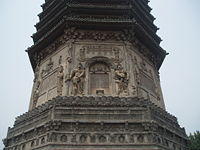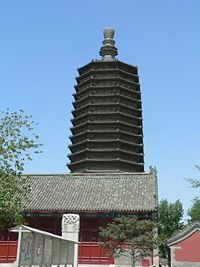
Pagoda of Tianning Temple (Beijing)
Encyclopedia
The Tianning Temple is located in the Guang'anmen district of Beijing
, China
. The temple contains the 12th-century Pagoda of Tianning Temple. The pagoda is a Liao Dynasty
pagoda built from around 1100 to 1119 or 1120 CE, shortly before the Liao Dynasty was conquered by Song
and Jin. This thirteen story, 57.8 m (189 ft) tall, octagonal-based Chinese pagoda
is made of brick and stone, yet imitates the design of wooden-constructed pagodas
from the era by featuring ornamental dougong
(bracket
supports). It rests on a large square platform, with the bottom portion of the pagoda taking on the shape of a sumeru
pedestal. The pagoda features a veranda with banisters, yet is entirely solid with no hollow inside or staircase as some pagodas feature. Other ornamental designs include arched doorways and heavenly Buddhist guardians. Its design inspired that of later pagodas, such as the similar Ming Dynasty
era Pagoda of Cishou Temple
of Beijing built in 1576.
 The structure and ornamentation have remained the same since the pagoda was built, but a major earthquake in 1976
The structure and ornamentation have remained the same since the pagoda was built, but a major earthquake in 1976
caused the original pearl-shaped steeple of the pagoda to break off and fall. It has since been restored. The temple grounds surrounding the pagoda have also been renovated and rebuilt several times over the course of the Ming
and Qing
dynasties. The architectural historian Liang Sicheng
(1901–1972)—known for discovering and documenting the oldest existent wooden structures still standing in China—lauded the Pagoda of Tianning Temple as a pristine architectural design of antiquity.

Beijing
Beijing , also known as Peking , is the capital of the People's Republic of China and one of the most populous cities in the world, with a population of 19,612,368 as of 2010. The city is the country's political, cultural, and educational center, and home to the headquarters for most of China's...
, China
China
Chinese civilization may refer to:* China for more general discussion of the country.* Chinese culture* Greater China, the transnational community of ethnic Chinese.* History of China* Sinosphere, the area historically affected by Chinese culture...
. The temple contains the 12th-century Pagoda of Tianning Temple. The pagoda is a Liao Dynasty
Liao Dynasty
The Liao Dynasty , also known as the Khitan Empire was an empire in East Asia that ruled over the regions of Manchuria, Mongolia, and parts of northern China proper between 9071125...
pagoda built from around 1100 to 1119 or 1120 CE, shortly before the Liao Dynasty was conquered by Song
Song Dynasty
The Song Dynasty was a ruling dynasty in China between 960 and 1279; it succeeded the Five Dynasties and Ten Kingdoms Period, and was followed by the Yuan Dynasty. It was the first government in world history to issue banknotes or paper money, and the first Chinese government to establish a...
and Jin. This thirteen story, 57.8 m (189 ft) tall, octagonal-based Chinese pagoda
Chinese pagoda
Chinese Pagodas are a traditional part of Chinese architecture. In addition to religious use, since ancient times Chinese pagodas have been praised for the spectacular views which they offer, and many famous poems in Chinese history attest to the joy of scaling pagodas.-History:The pagoda is...
is made of brick and stone, yet imitates the design of wooden-constructed pagodas
Ancient Chinese wooden architecture
Ancient Chinese wooden architecture is among the least studied of any of the world's great architectural traditions from the western point of view. Although Chinese architectural history reaches far back in time, descriptions of Chinese architecture are often confined to the well known Forbidden...
from the era by featuring ornamental dougong
Dougong
Dougong is a unique structural element of interlocking wooden brackets, one of the most important elements in traditional Chinese architecture....
(bracket
Bracket
Brackets are tall punctuation marks used in matched pairs within text, to set apart or interject other text. In the United States, "bracket" usually refers specifically to the "square" or "box" type.-List of types:...
supports). It rests on a large square platform, with the bottom portion of the pagoda taking on the shape of a sumeru
Sumeru
Sumeru or Sineru is the name of the central world-mountain in Buddhist cosmology. Etymologically, the proper name of the mountain is Meru , to which is added the approbatory prefix su-, resulting in the meaning "excellent Meru" or "wonderful Meru".The concept of Sumeru is closely related to the...
pedestal. The pagoda features a veranda with banisters, yet is entirely solid with no hollow inside or staircase as some pagodas feature. Other ornamental designs include arched doorways and heavenly Buddhist guardians. Its design inspired that of later pagodas, such as the similar Ming Dynasty
Ming Dynasty
The Ming Dynasty, also Empire of the Great Ming, was the ruling dynasty of China from 1368 to 1644, following the collapse of the Mongol-led Yuan Dynasty. The Ming, "one of the greatest eras of orderly government and social stability in human history", was the last dynasty in China ruled by ethnic...
era Pagoda of Cishou Temple
Pagoda of Cishou Temple
The Pagoda of Cishou Temple , originally known as Yong'anwanshou Pagoda , is a 16th century stone and brick Chinese pagoda located in the Buddhist Cishou Temple of Balizhuang, a suburb of Beijing, China. This octagonal-shaped pagoda is roughly 50 m tall, with elaborate ornamental carvings,...
of Beijing built in 1576.

1976 Tangshan earthquake
The Tangshan Earthquake also known as the Great Tangshan Earthquake, was a natural disaster that occurred on July 28, 1976. It is believed to be the largest earthquake of the 20th century by death toll. The epicenter of the earthquake was near Tangshan in Hebei, People's Republic of China, an...
caused the original pearl-shaped steeple of the pagoda to break off and fall. It has since been restored. The temple grounds surrounding the pagoda have also been renovated and rebuilt several times over the course of the Ming
Ming Dynasty
The Ming Dynasty, also Empire of the Great Ming, was the ruling dynasty of China from 1368 to 1644, following the collapse of the Mongol-led Yuan Dynasty. The Ming, "one of the greatest eras of orderly government and social stability in human history", was the last dynasty in China ruled by ethnic...
and Qing
Qing Dynasty
The Qing Dynasty was the last dynasty of China, ruling from 1644 to 1912 with a brief, abortive restoration in 1917. It was preceded by the Ming Dynasty and followed by the Republic of China....
dynasties. The architectural historian Liang Sicheng
Liang Sicheng
Liang Sicheng was the son of Liang Qichao, a well-known Chinese thinker in the late Qing Dynasty. Liang Sicheng returned to China from the United States after studying at the University of Pennsylvania...
(1901–1972)—known for discovering and documenting the oldest existent wooden structures still standing in China—lauded the Pagoda of Tianning Temple as a pristine architectural design of antiquity.

See also
- Chinese architectureChinese architectureChinese architecture refers to a style of architecture that has taken shape in East Asia over many centuries. The structural principles of Chinese architecture have remained largely unchanged, the main changes being only the decorative details...
- Architecture of the Song DynastyArchitecture of the Song DynastyThe architecture of the Song Dynasty was noted for its towering Buddhist pagodas, enormous stone and wooden bridges, lavish tombs, and palaces. Although literary works on architecture existed beforehand, architectural writing blossomed during the Song Dynasty, maturing into a more professional...
- Tianning Temple (Changzhou)
- History of BeijingHistory of BeijingThe city of Beijing has a long and rich history that dates back over 3,000 years. Prior to the unification of China by the First Emperor in 221 BC, Beijing was for centuries the capital of the ancient state of Yan. During the first millennia of imperial rule, Beijing was a provincial city in...

